ganglia的部署步骤
我是目录
- ganglia的部署步骤
- 1 简介ganglia
- 2 环境部署
- 3 第一个节点的部署
- 4 第二、三个节点的部署
- 5 web端的启动
1 简介ganglia
这块就长话短说,百度很多,ganglia分为三个组件,分别是gmetad,gmond,gweb。
gmetad:简单来说就是为了整合所有信息
gmond:类似与子节点,需要部署在每台主机上
gweb:进行可视化界面
在配置的时候请注意选择单播模式还是组播模式,不然很容易出错,这里部署采用单播模式。简单介绍一下单播和组播。
单播:代表主机之间一对一的通讯模式,也就说gmond的收集信息会直接反馈给gmetad。
组播:代表主机之间一对一组的通讯模式,一个gmetad可以接受多个gmod组成一组的信息
2 环境部署
在安装ganglia时,前提必要条件就是搭建所需的依赖,这块只需要复制粘贴即可。
yum进行安装
1 首先看一下自己主机上的EPEL源
rpm -qa | grep epel

如果没有出现依赖,则需要自己下载一个。
还需要下载一个httpd,用来进行web访问的
yum -y install httpd
安装依赖源
rpm -Uvh http://dl.fedoraproject.org/pub/epel/6/i386/epel-release-6-8.noarch.rpm
2 安装完依赖之后再进行查询,看看有没有ganglia包
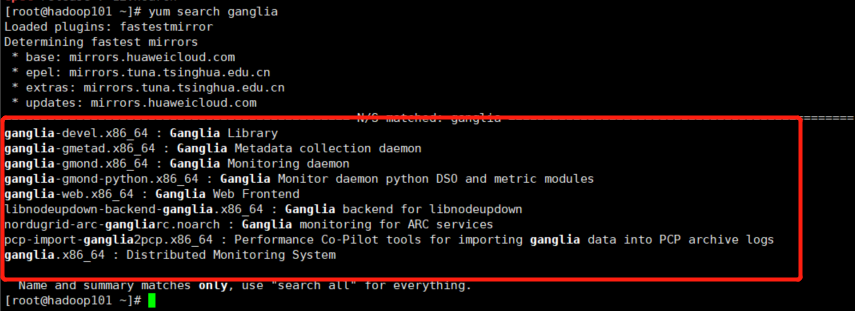
必须要有,没有就不能进行安装!!!
如果安装了依赖也找不到的话,尝试下面的语句再进行查询
yum -y install epel-release
继续安装相应依赖包
yum -y install httpd-devel automake autoconf libtool ncurses-devel libxslt groff pcre-devel pkgconfig php
3 第一个节点的部署
3 安装节点
我有三台服务器,分别是hadoop101 hadoop102 hadoo103,我将在hadoop101上进行安装gmetad,gmond,剩下两个节点则安装gmond即可。

①进行hadoop101上gmetad的安装
yum search ganglia
yum install -y ganglia-gmetad.x86_64 ganglia-web.x86_64
这个版本号就是search出来的,要复制对了,你的可能和我不一样
rpm -qa | grep ganglia
9.2日-补充:我今天又重新做了一遍,发现CentOS7在yum安装时会出现错误。
这是因为CentOS7默认安装的python版本是2.7,CentOS6则是2.6版本,2.6版本符合最新的ganglia,yum安装不会出错。
那这块只能采取编译安装了,编译安装我重新写一个文档,做个链接。
编译安装请看这里
编译安装请看这里
编译安装请看这里
ps:最近闹肚子,把公司的编译安装写了,不写这上面的了,直不起腰了。
进行配置,默认安装位置为/etc/ganglia/gmetad.conf

双引号里的是你监控集群的名字,集群名字后面的gmond都要用到,后面则是跟着你的IP地址,我写的是hostsname
②进行hadoop101上gmond的安装
yum search ganglia
yum install -y ganglia-gmond.x86_64
安装完成后进行gmond.conf的配置
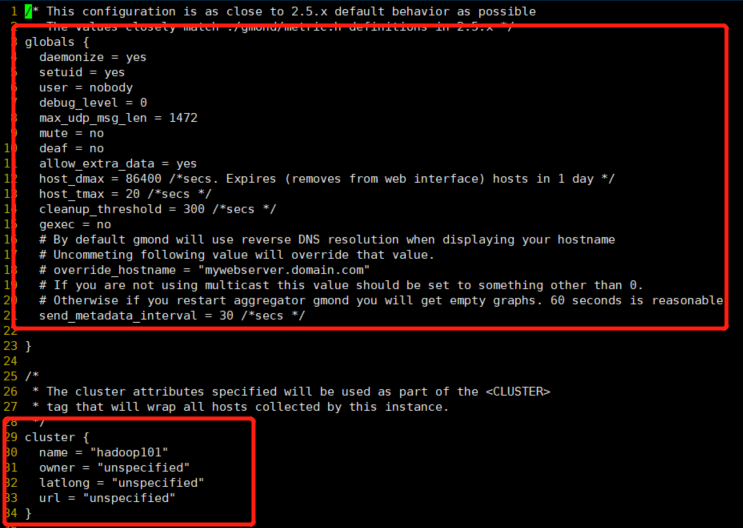

注意红框的配置,文本如下:
globals {
4 daemonize = yes
5 setuid = yes
6 user = nobody
7 debug_level = 0
8 max_udp_msg_len = 1472
9 mute = no
10 deaf = no
11 allow_extra_data = yes
12 host_dmax = 86400 /*secs. Expires (removes from web interface) hosts in 1 day */
13 host_tmax = 20 /*secs */
14 cleanup_threshold = 300 /*secs */
15 gexec = no
16 # By default gmond will use reverse DNS resolution when displaying your hostname
17 # Uncommeting following value will override that value.
18 # override_hostname = "mywebserver.domain.com"
19 # If you are not using multicast this value should be set to something other than 0.
20 # Otherwise if you restart aggregator gmond you will get empty graphs. 60 seconds is reasonable
21 send_metadata_interval = 30 /*secs */
22
23 }
24
25 /*
26 * The cluster attributes specified will be used as part of the <CLUSTER>
27 * tag that will wrap all hosts collected by this instance.
28 */
29 cluster {
30 name = "hadoop101"
31 owner = "unspecified"
32 latlong = "unspecified"
33 url = "unspecified"
34 }
35
36 #Hadoop集群监控,你们不需要配置这个
37 cluster{
38 name = "Hadoop"
39 owner = "umspecified"
40 latlong = "unspecified"
41 url = "unspecified"
42 }
43
44
45 /* The host section describes attributes of the host, like the location */
46 host {
47 location = "unspecified"
48 }
49
50 /* Feel free to specify as many udp_send_channels as you like. Gmond
51 used to only support having a single channel */
52 udp_send_channel { ----发送端
53 #bind_hostname = yes # Highly recommended, soon to be default.
54 # This option tells gmond to use a source address
55 # that resolves to the machine's hostname. Without
56 # this, the metrics may appear to come from any
57 # interface and the DNS names associated with
58 # those IPs will be used to create the RRDs.
59 # mcast_join = 239.2.11.71 删除组播
60 host=hadoop101
61 port = 8649
62 ttl = 1
65 /* You can specify as many udp_recv_channels as you like as well. */
66 udp_recv_channel {---接受端
67 # mcast_join = 239.2.11.71 把组播删除了
68 port = 8649
69 bind = hadoop101
70 retry_bind = true
71 # Size of the UDP buffer. If you are handling lots of metrics you really
72 # should bump it up to e.g. 10MB or even higher.
73 # buffer = 10485760
74 }
75
76 /* You can specify as many tcp_accept_channels as you like to share
77 an xml description of the state of the cluster */
78 tcp_accept_channel {---请求
79 port = 8649
80 # If you want to gzip XML output
81 # gzip_output = no
82 }
83
84 /* Channel to receive sFlow datagrams */
85 #udp_recv_channel {
86 # port = 6343
87 #}
安装gweb
yum search ganglia
yum install -y ganglia-gmetad.x86_64 ganglia-web.x86_64
rpm -qa | grep ganglia
至此hadoop101的ganglia就配置完成了
4 第二、三个节点的部署
同样的操作在hadoop102,hadoop103上,只需安装gmond即可
yum search ganglia
yum install -y ganglia-gmond.x86_64
/* This configuration is as close to 2.5.x default behavior as possible
2 The values closely match ./gmond/metric.h definitions in 2.5.x */
3 globals {
4 daemonize = yes
5 setuid = yes
6 user = nobody
7 debug_level = 0
8 max_udp_msg_len = 1472
9 mute = no
10 deaf = yes
11 allow_extra_data = yes
12 host_dmax = 86400 /*secs. Expires (removes from web interface) hosts in 1 day */
13 host_tmax = 20 /*secs */
14 cleanup_threshold = 300 /*secs */
15 gexec = no
16 # By default gmond will use reverse DNS resolution when displaying your hostname
17 # Uncommeting following value will override that value.
18 # override_hostname = "mywebserver.domain.com"
19 # If you are not using multicast this value should be set to something other than 0.
20 # Otherwise if you restart aggregator gmond you will get empty graphs. 60 seconds is reasonable
21 send_metadata_interval = 30 /*secs */
22
23 }
24
25 /*
26 * The cluster attributes specified will be used as part of the <CLUSTER>
27 * tag that will wrap all hosts collected by this instance.
28 */
29 cluster {
30 name = "hadoop101"
31 owner = "unspecified"
32 latlong = "unspecified"
33 url = "unspecified"
34 }
35
36 #Hadoop集群监控
37 cluster{
38 name = "Hadoop"
39 owner = "umspecified"
40 latlong = "unspecified"
41 url = "unspecified"
42 }
43
44 /* The host section describes attributes of the host, like the location */
45 host {
46 location = "unspecified"
47 }
48
49 /* Feel free to specify as many udp_send_channels as you like. Gmond
50 used to only support having a single channel */
51 udp_send_channel {
52 #bind_hostname = yes # Highly recommended, soon to be default.
53 # This option tells gmond to use a source address
54 # that resolves to the machine's hostname. Without
55 # this, the metrics may appear to come from any
56 # interface and the DNS names associated with
57 # those IPs will be used to create the RRDs.
58 # mcast_join = 239.2.11.71
59 host = hadoop101
60 port = 8649
61 ttl = 1
62 }
63
64 /* You can specify as many udp_recv_channels as you like as well. */
65 udp_recv_channel {
66 # mcast_join = 239.2.11.71
67 port = 8649
68 bind = hadoop101
69 retry_bind = true
70 # Size of the UDP buffer. If you are handling lots of metrics you really
71 # should bump it up to e.g. 10MB or even higher.
72 # buffer = 10485760
73 }
74
75 /* You can specify as many tcp_accept_channels as you like to share
76 an xml description of the state of the cluster */
77 tcp_accept_channel {
78 port = 8649
79 # If you want to gzip XML output
80 gzip_output = no
81 }
82
83 /* Channel to receive sFlow datagrams */
84 #udp_recv_channel {
85 # port = 6343
86 #}
87
主要改
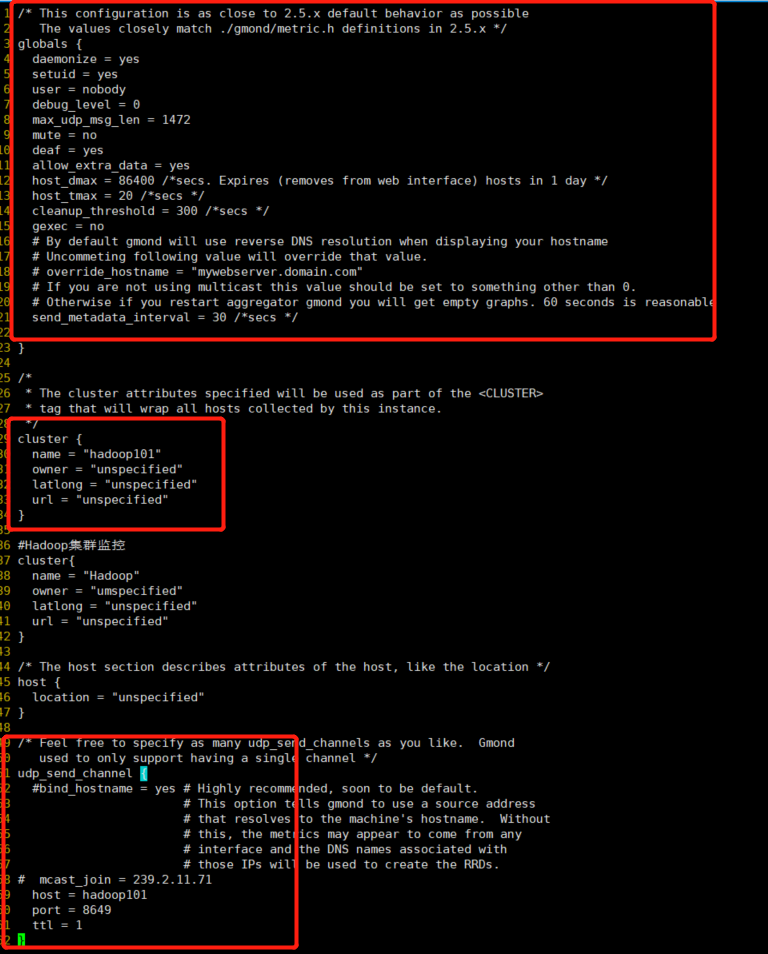
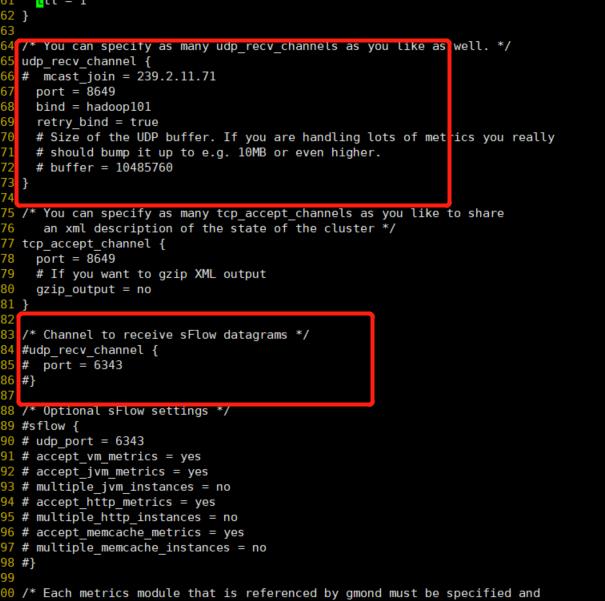
至此hadoop102,hadoop103的gmond节点修改完毕
5 web端的启动
在hadoop101上启动:
service gmetad start
service gmond start
service httpd start
service gmetad status -------------------验证是否启动成功
service gmond status
在hadoop102,103上启动
service gmond start
访问web界面:(你的ip)/ganglia
如果操作正常应给就没问题,但是也会出现访问失败:
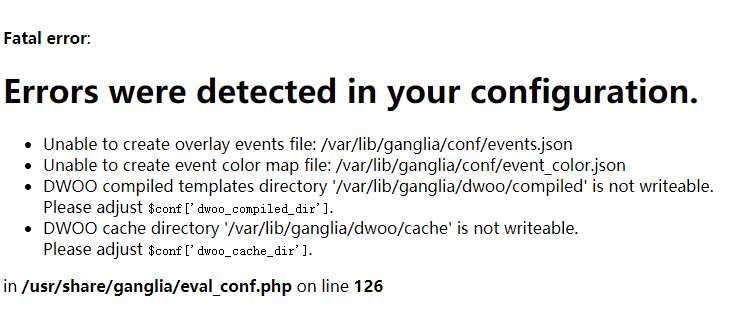
解决办法:
没有权限进行读写操作,执行一下代码
chmod 777 /var/lib/ganglia/dwod/compiled
chmod 777 /var/lib/ganglia/dwoo/cache
然后又出错了

说没有这两个文件,这说明在安装的时候出现了一点问题,不过不要紧,两个办法:
第一个办法,找一下看看这两个文件在哪,然后搜索出来后有一堆,你分别打开看看,
里面只有一对{},复制到报错的路径下就可以了。
find / -name events.json
find / -name enent_color.json
第二个办法,直接touch events.json,touch enent_color.json,在里面写入
{}即可
重新登录
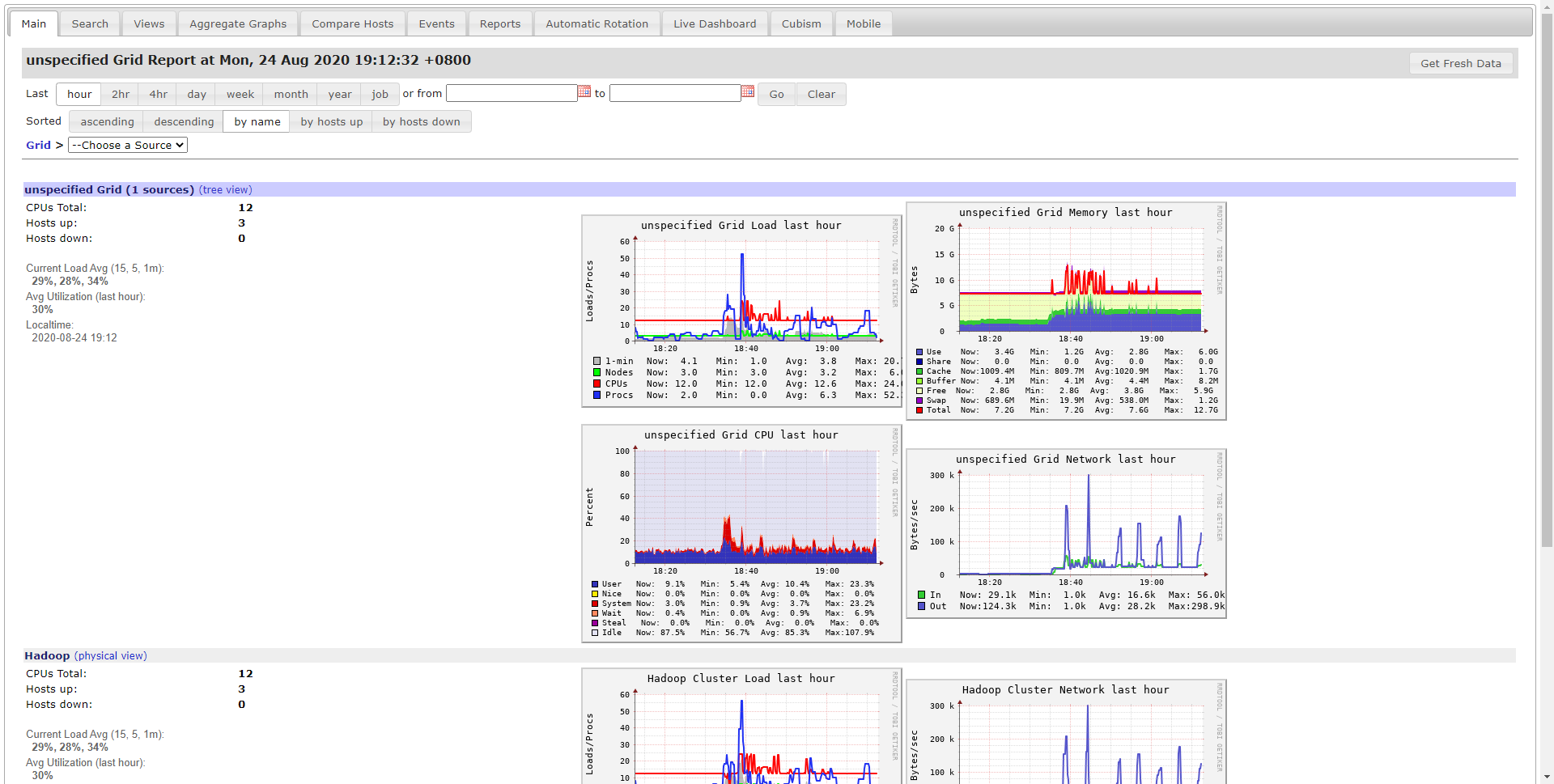
如果出现没有数据,则说明节点配置问题,在好好看看配置不要错了。本次配置为单播配置,比较简单。
祝你成功!如果有帮助请点个赞让我开心下!
最后
以上就是迷路灰狼最近收集整理的关于【亲测】部署ganglia进行监控--部署过程及Error解决ganglia的部署步骤的全部内容,更多相关【亲测】部署ganglia进行监控--部署过程及Error解决ganglia内容请搜索靠谱客的其他文章。









发表评论 取消回复